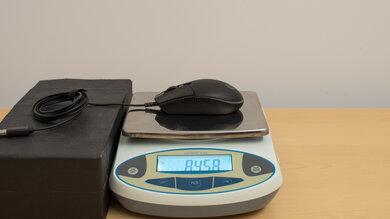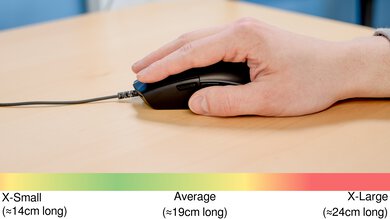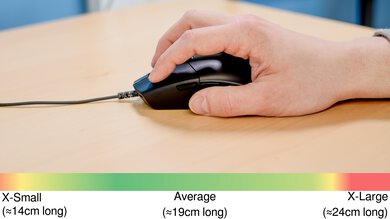The Logitech G203 LIGHTSYNC is a great wired gaming mouse. It feels very well-built, and it has extremely low click latency. It also has a wide CPI range, and you can adjust the set CPI by increments of 50. It isn't ideal for larger hands using a palm or claw grip, but it should be comfortable for all hand sizes using a fingertip grip. It has RGB lighting zones in the logo and three independent zones in a band that runs around the back. The companion software offers plenty of customization options and is compatible with Windows and macOS.
Our Verdict
The Logitech G203 LIGHTSYNC is satisfactory for office use. It feels well-built, has a good number of programmable buttons, the software is compatible with Windows and macOS, and it's well-suited for smaller hands. However, those with large or extra-large hands may not find a palm or claw grip comfortable due to its short length. Unfortunately, you can't use this mouse wirelessly, and the mouse wheel lacks L/R tilt buttons and doesn't unlock for free scrolling.
- Feels very well-built.
- Software offers plenty of options and is compatible with Windows and macOS.
- Plenty of programmable buttons and G-Shift capability for a second layer of commands.
- Mouse feet that glide well on desks and mousepads.
- Very consistent sensor whether you're moving your cursor fast or slow.
- Wired-only.
- Scroll wheel lacks L/R tilt buttons and doesn't unlock for free scrolling.
- Not a very ergonomic design, and small size only suitable for smaller hands or fingertip grip.
The Logitech G203 LIGHTSYNC is an excellent FPS gaming mouse. It feels well-built, has exceptionally low click latency, and has an ambidextrous shape that's ideal for a fingertip grip, regardless of hand size. It also has good feet that glide well on desks or mousepads. Unfortunately, its rubber cable isn't very flexible.
- Feels very well-built.
- Software offers plenty of options and is compatible with Windows and macOS.
- Outstanding click latency.
- Mouse feet that glide well on desks and mousepads.
- Very consistent sensor whether you're moving your cursor fast or slow.
- Somewhat heavy.
- Cable isn't very flexible.
The Logitech G203 LIGHTSYNC is decent for MMO gaming, but it doesn't have nearly as many buttons as a dedicated MMO mouse, and the cable isn't very flexible. It feels well-built and has remarkably low click latency and a low lift-off distance. Those with larger hands likely won't be able to use the mouse comfortably using a claw or palm grip, but a fingertip grip should be comfortable for all hand sizes. The software offers plenty of customizable options, it's compatible with Windows and macOS, and it allows you to set a secondary layer of commands by assigning a G-Shift button.
- Feels very well-built.
- Software offers plenty of options and is compatible with Windows and macOS.
- Outstanding click latency.
- Mouse feet that glide well on desks and mousepads.
- Very consistent sensor whether you're moving your cursor fast or slow.
- Not nearly as many side buttons as a dedicated MMO mouse.
- Not a very ergonomic design, and small size only suitable for smaller hands or fingertip grip.
- Cable isn't very flexible.
- Feels very well-built.
- Mouse feet that glide well on desks and mousepads.
- Very consistent sensor whether you're moving your cursor fast or slow.
Changelog
-
Updated Oct 10, 2025:
We've added a link to the SteelSeries Rival 3 Gen 2 to the Hand Size Recommendation section.
- Updated Aug 19, 2025: We've converted this review to Test Bench 1.5.1. This update removes less relevant or redundant elements, including several videos. We've also adjusted our Sensor Latency testing, resulting in minor score changes. See our full 1.5.1 changelog for details.
-
Updated Nov 25, 2024:
We've corrected an error where we had stated that this mouse doesn't have onboard memory.
- Updated Jan 05, 2024: We've updated the CPI graph displayed in the Sensor Latency section of this review. Our results remain the same, but these graphs have two new columns with results from the Delay At Half Movement and Delay To End Of Movement tests.
Check Price
Differences Between Sizes And Variants
The Logitech G203 LIGHTSYNC is an update of the Logitech G203 Prodigy. The unit we tested is black, but it's also available in blue, lilac, and white color variants. There's also a variant available in some regions called the Logitech G102 LIGHTSYNC, which we haven't tested but expect to perform similarly. You can see the label for our unit here.
Popular Mouse Comparisons
The G203 LIGHTSYNC gaming mouse is an update of the Logitech G203 Prodigy. The LIGHTSYNC has three independent RGB zones in the band around the back, while the Prodigy has one. This mouse offers solid performance and can be a good choice if you're looking for a budget option and you prefer a fingertip grip or have smaller hands.
For other options, see our recommendations for the best wired mouse, the best cheap gaming mouse, and the best Logitech mouse.
The Logitech G305 LIGHTSPEED and the Logitech G203 LIGHTSYNC are very similar gaming mice but have a few standout differences. The LIGHTSYNC scores better for gaming across the board, but it's wired only, has a narrower CPI range, and while it has a somewhat better click latency, most people likely won't notice a difference. Despite scoring lower, the LIGHTSPEED may be a better gaming mouse for some. It connects wirelessly with a USB receiver but is heavier since it's powered by an AA battery. It doesn't have RGB lighting, but this may not bother some people. Both mice are well-suited for all hand sizes using a fingertip grip, and only those with larger hands may find a palm or claw grip uncomfortable.
The Logitech G203 LIGHTSYNC and the Razer DeathAdder Essential are wired gaming mice, but the Logitech is a better choice if you prefer lighter, ambidextrous-shaped mice. Also, it has a wider CPI range, a more precisely adjustable CPI, a lower lift of distance, and a much lower latency. Comparatively, you may find the Razer's larger, right-handed shape more comfortable when using a palm or claw grip if you have larger hands.
The Logitech G203 LIGHTSYNC and the Logitech G305 HERO are both wired gaming mice, but the G305 HERO performs better overall. It's much more comfortable to use thanks to its right-handed slant and thumb rest. It also has more programmable inputs, a wider CPI range, and a scroll wheel that unlocks for free scrolling. On the other hand, the G203 LIGHTSYNC is much lighter and has comparably good click latency.
The Logitech G203 LIGHTSYNC is an update of the Logitech G203 Prodigy. The two mice are nearly identical, but the LIGHTSYNC has three independent RGB zones within the band that wraps around the back, while the Prodigy only has one. The LIGHTSYNC also has a somewhat lower click latency, but most people likely won't notice a difference.
Test Results

If you're interested in a lighter mouse with honeycomb cutouts in the body to reduce the overall weight, check out the EQEOVGA D10 RGB.
The Logitech G203 LIGHTSPEED has an egg-shaped design that tapers toward both the front and back, making it a versatile choice for palm, claw, or fingertip grips for most hand sizes.
If you're interested in a wired gaming mouse with a shape that's wider at the rear and tapers toward the front, making it best-suited for claw or fingertip grips, check out the SteelSeries Rival 3 Gen 2.
The rubber cable feels slightly more flexible than the cable on the Logitech G203 Prodigy.
If you're interested in a similar wired gaming mouse with five side buttons, check out the SteelSeries Rival 5. If you'd prefer a mouse with a pair of buttons behind the scroll wheel to adjust CPI up or down on the fly instead of a single button to cycle CPI profiles, check out the ASUS TUF Gaming M3. Or, for a mouse with hot-swappable left and right-click switches, look into the SteelSeries Prime.
Logitech doesn't advertise this mouse's specific sensor model. When this review was first published, our results indicated this mouse uses a Mercury sensor, like its predecessor, the Logitech G203 Prodigy. However, after receiving community feedback that our result may be wrong, we opened the unit we bought and tested to check.
We confirmed that this mouse uses an 1855 sensor. You can see an image of our unit with the sensor visible here.
The polling rate options are 125Hz, 250Hz, 500Hz, and 1000Hz.
While no software issues were present during testing, many users online have reported various problems with Logitech's G HUB software, including but not limited to startup issues, freezing, and connection issues with some devices. If you'd like to share your experience using Logitech G HUB with this mouse, feel free to leave a comment in the discussions section. If you're interested in a gaming mouse that allows you to change a variety of settings directly on the mouse without using any companion software, check out the SteelSeries Prime+.












